Top speed 975 km/h Weight 4,818 kg Length 11 m | Range 2,391 km Wingspan 11 m First flight August 9, 1950 | |
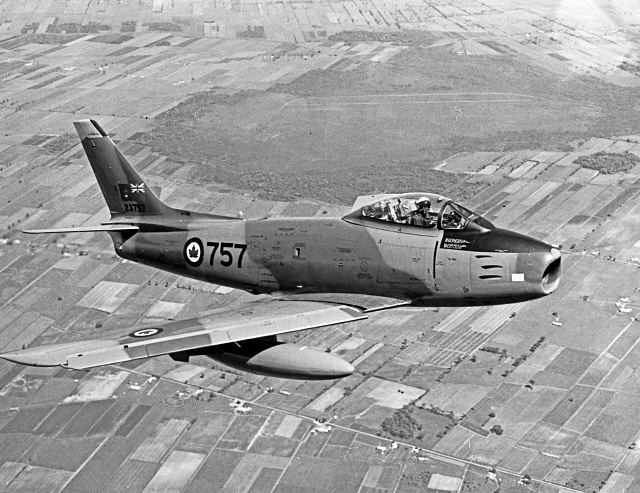 | ||
Engine types Avro Canada Orenda, Turbojet | ||
War thunder canadair sabre jet cl 13a mk 5 german top tier
The Canadair Sabre was a jet fighter aircraft built by Canadair under licence from North American Aviation. A variant of the North American F-86 Sabre, it was produced until 1958 and used primarily by the Royal Canadian Air Force (RCAF) until replaced with the Canadair CF-104 in 1962. Several other air forces also operated the aircraft.
Contents
- War thunder canadair sabre jet cl 13a mk 5 german top tier
- Design and development
- Operational history
- Womens speed records
- Golden Hawks
- Variants
- Operators
- References
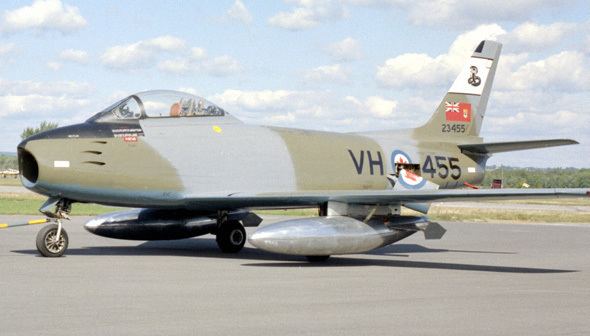
Design and development
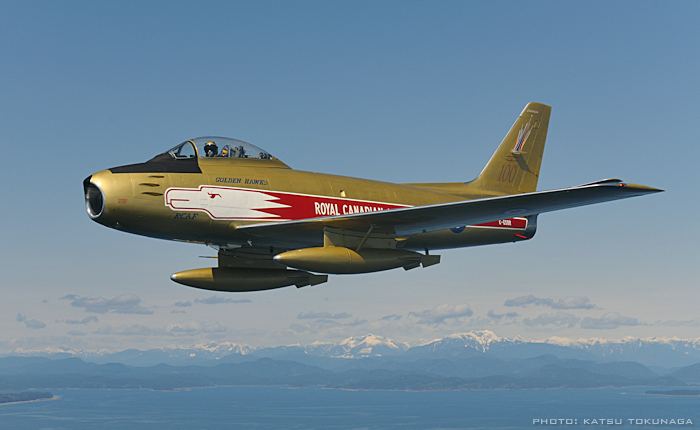
In 1948, the Canadian government decided to re-equip the RCAF with the F-86 Sabre with Canadair contracted to produce them in Montreal, Quebec, Canada. An initial batch of 10 aircraft was ordered for tool verification. The Korean War changed this to a production batch of 100 aircraft. Canadair slowly built up its production facility to make all components with related equipment obtained from other Canadian suppliers. Canadair gave the Sabre the project number CL-13.
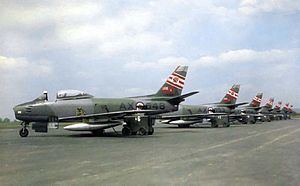
Canadair produced six versions of the CL-13 Sabre. The sole Sabre Mk.1 was essentially the same as the North American Sabre F-86A. It had a General Electric J47-GE-13 turbojet of 5,200 lbf (23 kN) thrust. The Sabre Mk.2 had the same engine, although after the first 20 aircraft were produced, the remainder of the production run was distinguished in having power-assisted controls and an "all-flying" tailplane. The sole Sabre Mk 3 was the first of the Canadian Sabres to use the Avro Canada Orenda turbojet (Orenda 3 with 6,000 lbf (27 kN) thrust). The Sabre Mk.4 retained the General Electric engine and was destined for the RAF and was later passed on to other overseas air forces. The Sabre Mk.5 was the next production version, equipped with an Orenda 10 with 6,500 lbf (29 kN) thrust. A change to the Orenda 14 with 7,440 lbf (33 kN) powered the Sabre Mk.6. The designation Sabre Mk.7 was mainly experimental.
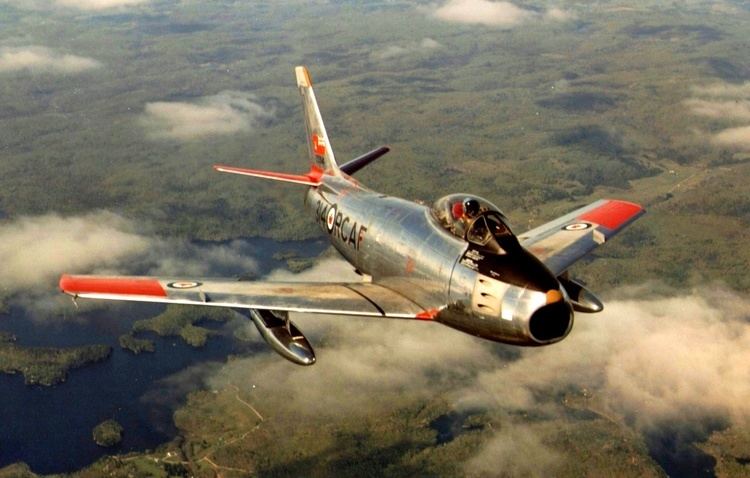
The last Sabre to be manufactured by Canadair (Sabre #1815), after being donated by the Pakistan Air Force, is now part of the permanent collection in the Western Canada Aviation Museum (WCAM) in Winnipeg, Manitoba. From 1950 to 1958, a total of 1,815 CL-13 Sabres were built at the Canadair plant in Montreal.
Operational history
The second generation of Canadair Sabre aircraft, and first to be built in quantity, was the Mk 2, with 350 produced from 1952–1953. The RCAF received 290 of these improved aircraft. During the first half of 1952, the remaining 60 Mk.2s were supplied to the U.S. Air Force for use in the Korean War. Most RCAF Mk.2 Sabres were utilized in the air defence role with NATO's No. 1 Air Division in Europe, proving itself to be an outstanding dogfighter. Others were assigned to the training role at bases in Canada. After replacement by the Sabre 5 in RCAF service from 1954, just over 210 surviving Sabre 2s were overhauled and modified in the UK and supplied in roughly equal numbers to the Greek Air Force and Turkish Air Forces.
In mid-1952, the Sabre Mk.4 went into production with the first one flown on 28 August 1952. Apart from some minor structural and systems changes, including improved air-conditioning and gun sight, the Mk 2 and the Mk 4 were identical. Of 438 Mk 4s built, approximately 70 were used temporarily by the RCAF, all surviving examples being passed to the RAF. The other Sabre 4s went directly to the RAF under a mutual aid program, equipping 11 RAF squadrons. The majority served in West Germany with NATO, with two squadrons being based in the UK as part of RAF Fighter Command. The Sabre Mk.4 served with the RAF until mid-1956 when they were replaced by Hawker Hunters. The survivors were overhauled in the UK, fitted with '6-3' wing modifications and handed to the USAF (which had funded these aircraft) which in turn passed them on to other NATO members, with the majority going to Italy and Yugoslavia.
On 30 July 1953, the first Sabre Mk.5 flew with the Orenda 10 engine, which gave it a clear rate of climb and ceiling advantage over earlier variants. Other Mk 5 improvements included a new oxygen system and improved maneuverability and low-speed characteristics achieved by increasing the wing chord by six in (15.2 cm) at the root and three in. (7.2 cm) at the wing tip along with fitting a small vertical wing fence. This modification, originated by North American on the F-86F, dramatically improved maneuverability, though the loss of the slatted leading edge increased landing speed and degraded low speed handling considerably. Canadair built 370 Mk 5s with the majority designated for use in the RCAF’s Air Division squadrons in Europe to replace the Mk.2s. A total of 75 RCAF Sabre 5s were transferred to the German Luftwaffe during 1957.
The Canadair Sabre Mk.6 was the final variant and was considered to be the "best" production Sabre ever built. It was equipped with a two-stage Orenda engine developing 7,275 lb (3,302 kg.) of static thrust. Its altitude performance and climb rate was enhanced over the Mk 5 and the reinstatement of the wing leading edge slat gave it excellent low-speed characteristics. The first production model was completed on 2 November 1954 and ultimately 655 were built with production terminating on 9 October 1958.
A total of 390 Mk 6s went to the RCAF with the majority replacing the existing Canadair Sabre Mk 5s at the Air Division squadrons in West Germany and France. The main air threats to NATO in the 1950s in Central Europe were the early variants of the Soviet MiG- the MiG-15, MiG-17, MiG-19 and MiG-21. Based on the Korean War experience, the selection of the Mk 6 Sabre to provide an effective opposition to the MiG threat proved to be a logical one. Canada’s commitment to NATO was to provide 12 squadrons located at four bases – two in France (Marville and Grostenquin) and two in West Germany (Zweibrücken and Baden Soellingen). Initially, the contribution consisted of only Sabre aircraft; however, later it was decided to include the Avro Canada CF-100 aircraft in the defense package to provide a night and all-weather fighter capability.
Though the main use of the Sabre by the RCAF was in Europe, they were also used by RCAF Auxiliary part-time units in Canada, replacing DeHavilland Vampire jets. 400 "City Of Toronto" and 411 "County Of York" Squadrons based at RCAF Station Downsview near Toronto, as well as 401 "City Of Westmount" and 438 "City Of Montreal" Squadrons at RCAF Station St-Hubert near Montreal, were equipped with Sabre 5s, as was 442 "City Of Vancouver" Squadron at RCAF Station Sea Island, near Vancouver.
In addition to the RCAF deliveries, 225 Canadair Mk 6 Sabres were exported to the West German Luftwaffe, six were delivered to the Colombian Air Force, and 34 went to the South African Air Force.
In January 1966, Germany sold 90 of its Canadian Mk 6 Sabres to Iran. These aircraft were quickly transferred to Pakistan and became the main day fighter of the Pakistan Air Force.
Canadair Sabres were the mainstay of their respective air forces in the two major conflicts in which they were employed: the Korean War where F-86 Sabres racked up an impressive 6-1 kill record and the Indo-Pakistani War of 1971 . The smaller more diminutive Folland Gnat was its main opponent in the Indo-Pakistan war. By the end of 1971, the Gnat proved to be a frustrating opponent for the larger, heavier and older Sabre. The Gnat was referred to as a "Sabre Slayer" by the Indian Air Force since most of its combat "kills" during the two wars were against Sabres. Although the Canadair Sabre Mk 6 was widely regarded as the best dogfighter of its era, tactics called for Gnats taking on the Sabres in the vertical arena, where the Sabres were at a disadvantage. Moreover, because the Gnat was lightweight and compact in shape, it was hard to see, especially at the low levels where most of the dogfights took place.
Women's speed records
In 1952, Jacqueline Cochran, then aged 47, decided to challenge the world speed record for women, then held by Jacqueline Auriol. She tried to borrow an F-86 from the U.S. Air Force, but was refused. She was introduced to an Air Vice-Marshal of the RCAF who, with the permission of the Canadian Minister of Defence, arranged for her to borrow 19200, the sole Sabre 3. Canadair sent a 16-man support team to California for the attempt. On 18 May 1953, Ms. Cochran set a new 100 km speed record of 1,050.15 km/h (652.5 mph). Later on 3 June, she set a new 15 km closed circuit record of 1078 km/h (670 mph). While she was in California, she exceeded 1270 km/h in a dive, and thus became the first woman to exceed the speed of sound.
Golden Hawks
The Golden Hawks were a Canadian aerobatic flying team that was established in 1959 to celebrate the Royal Canadian Air Force's 35th anniversary and the "Golden" 50th anniversary of Canadian flight, which began with the AEA Silver Dart in 1909. Initially, a six-plane team flying brilliantly-painted metallic-gold Canadair Sabre Mk.5s, was envisioned as performing for only one year, but the Golden Hawks were so popular after their single 63-show season that the team was expanded. In the following year, another plane was added to the team, allowing for a five-plane main formation with two solo jets. The Golden Hawks continued performing for three more seasons, changing to the Mk 6 in 1961, until they were disbanded on 7 February 1964, having flown a total of 317 shows across North America.
Variants
Operators
General characteristics
Performance
Armament
